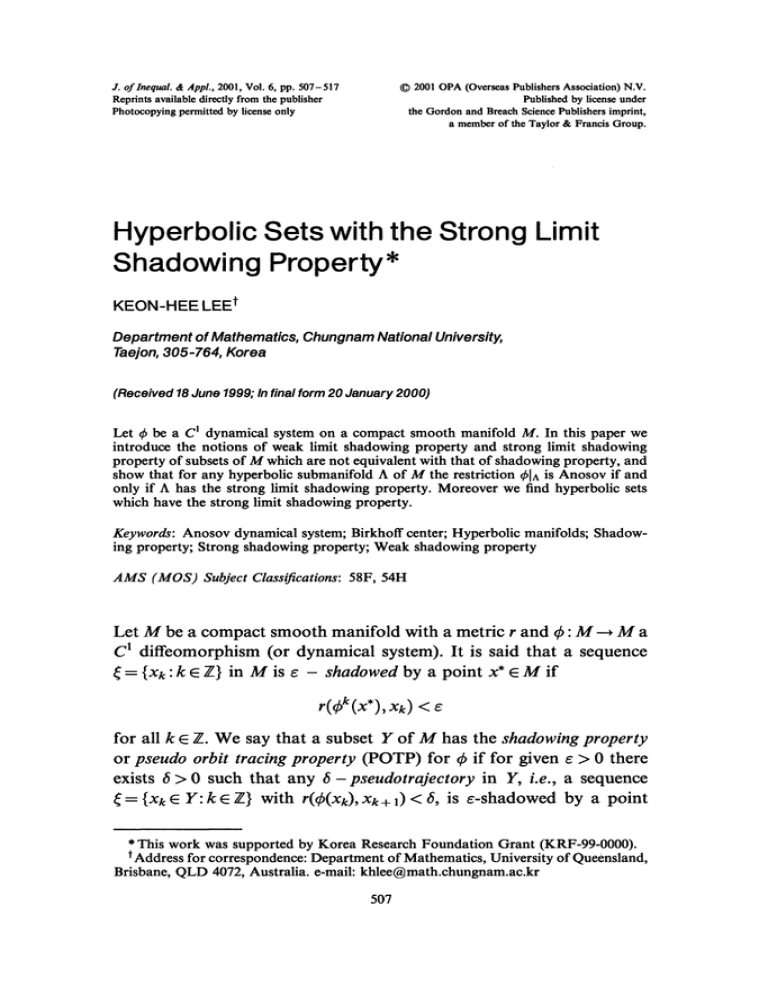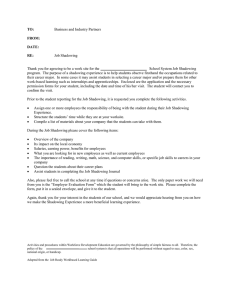Document 10944991
advertisement

(C) 2001 OPA (Overseas Publishers Association) N.V.
Published by license under
the Gordon and Breach Science Publishers imprint,
a member of the Taylor & Francis Group.
J. oflnequal. & Appl., 2001, Vol. 6, pp. 507-517
Reprints available directly from the publisher
Photocopying permitted by license only
Hyperbolic Sets with the Strong Limit
Shadowi ng Property*
KEON-HEE LEE
Department of Mathematics, Chungnam National University,
Taejon, 305-764, Korea
(Received 18 June 1999; In final form 20 January 2000)
Let b bca C dynamical system on a compact smooth manifold M. In this paper we
introduce the notions of weak limit shadowing property and strong limit shadowing
property of subsets of M which are not equivalent with that of shadowing property, and
show that for any hyperbolic submanifold A of M the restriction b[^ is Anosov if and
only if A has the strong limit shadowing property. Moreover we find hyperbolic sets
which have the strong limit shadowing property.
Keywords: Anosov dynamical system; Birkhoff center; Hyperbolic manifolds; Shadowing property; Strong shadowing property; Weak shadowing property
AMS (MOS) Subject Classifications: 58F, 54H
Let M be a compact smooth manifold with a metric r and b" M M a
C diffeomorphism (or dynamical system). It is said that a sequence
{xk :k E 7/} in M is e shadowed by a point x* E M if
r(k(x*),Xk) <
for all k 77. We say that a subset Y of M has the shadowing property
or pseudo orbit tracing property (POTP) for b if for given e > 0 there
exists 6 > 0 such that any 6- pseudotrajectory in Y, i.e., a sequence
(= {xk Y: k 77} with r((x), x+ l) < 8, is e-shadowed by a point
* This work was supported by Korea Research Foundation Grant (KRF-99-0000).
Address for correspondence: Department of Mathematics, University of Queensland,
Brisbane, QLD 4072, Australia. e-mail: khlee@math.chungnam.ac.kr
5O7
.
K.-H. LEE
508
x* E M. In this cas, the point x* is called a shadowing point of If this
property holds with Y= M, we say that b has the POTP.
Often pseudotrajectories are obtained as results of numerical studies of dynamical systems. In the context POTP means that numerically found trajectories with uniformly small errors are close to real
trajectories. In dynamical system theory, there are various types of
shadowing property.
In 1997, Eirola, Nevanlinna and Pilyugin introduced the concept of
the limit shadowing property and studied their properties (see [1]).
DEFINITION
(LmSP) for
b
A subset Y of M has the limit shadowing property
if for any sequence
{xk:k 7/} in Y with
r(ck(Xk),Xk+) --* 0 as
Ikl-* oo
there is a point x* M such that
r(rkk(x*),Xk) --* 0
as
Ik[-* c.
If this property holds with Y= M, we say that
has the LmSP.
From the numerical point of view, this property of a dynamical
system means the following: if we apply a numerical method that
approximates with "improving accuracy", so that one-step errors
tend to zero as time go to positive and negative infinity then the numerically obtained trajectories tend to real ones.
A closed invariant set A c M is said to be hyperbolic for if TAM
has a continuous splitting TAM EA @ EuA satisfying:
(1) E and E u are invariant under the derivative map TO;
(2) there exist constants e > 0 and 0 < A < 1 such that for any n 7/+
max (llr,"lll, IIT’-"III}
< cA".
We say that A c M is a hyperbolic manifold for b if A is a C compact invariant submanifold of M with a hyperbolic structure as a
subset of M. If M is hyperbolic for b then b is called Anosov.
Hirsch asks in [3], if A c M is a hyperbolic manifold for b, does it
follow that b restricted to A is Anosov (has a hyperbolic structure)?
The answer given by Franks and Robinson in [2] was negative.
STRONG SHADOWING PROPERTY
509
Recently, Lee and Kim [6] showed that if A has the strong
shadowing property then [A: A A is Anosov, and found hyperbolic
sets which have the strong shadowing property. It is a well-known fact
in dynamical system theory that if A is hyperbolic for then it has the
shadowing property, i.e., for given e > 0 there exists 6 > 0 such that
any
pseudotrajectory in A is e shadowed by a point x* M. In
general, the shadowing point x* need not belong to A. We say that A
has the strong shadowing property if the shadowing point x* belongs
to A (for more details, see [6] ).
In this paper we introduce the concept of the weak limit shadowing
property which is different from that of POTP. Moreover we will
discuss that [A is Anosov if and only if A has the strong limit
shadowing property, and find hyperbolic sets which have the strong
limit shadowing property.
DEFINITION 2 A subset Y of M has the weak limit shadowing
property (weak LmSP) for if there exists a constant do > 0 such
that for any 0 < d < do and d-pseudotrajectory
{Xk" k E 7/} in Y
with
r(O(Xk),Xk+)
0 as
Ikl
there is a point x* E M such that
r(k(X*),Xk)
0 as
[kl---, o.
In this case, the point x* is called a limit shadowing point of .-If this
property holds with Y= M, we say that has the weak LmSP.
It is easy to show that there exist systems which do not have the
weak LmSP.
Example 3 Consider the circle S with coordinate x E [0, 1) and a
of S given by (x)=x. For any do > 0 and
diffeomorphism
0 < d < do, choose n
satisfying (l/n) < d. Let
{Xk :k 7/} be a
sequence in S defined by
0
if k=0
Xk-+(1/n+k) (modl) ifk>l
Xk+-(1/n--k) (modl) if k< -1
K.-H. LEE
510
Then
is a d-pseudotrajectory in S with
r(rb(Xk), Xk+l)
1
0 as
n+k *
But we can see that for any point x* E S
r(g)k(x*),Xk) -/* 0
,
Ikl
o
Ikl--* c.
as
Clearly we know that the LmSP implies the weak LmSP. However
the following example shows that the weak LmSP is not equivalent to
the LmSP. Moreover we can see that a dynamical system which has
the weak LmSP need not have the POTP.
Example 4 Consider the circle S with coordinate x E[0, 1) and a
diffeomorphism on S with the following properties;
b(x)=x ifx
b(x)>x ifx
0, {1)
(1)
{ 0,, _}
and b(x)<x ifxe
,1
(1)
Then we can see that b does not have the LmSP. In fact, let
{Xk" k 7/} be a sequence in S given by
0 if k>0,
Xk
if k<0.
Then ( is a pseudotrajectory with
r(b(xk), xt,+l)
,
0 as
Ikl
oo.
But we can see that for any point x* E S we have
r(g)k(x*),X)
Moreover it is easy to show that
0 as
Ik[--*
does not have the POTP.
To show that b has the weak LmSP, we let a 0, b (1/4), c (1/2).
For any n N, we let V denote the (1/n)-neighborhood of the points
STRONG SHADOWING PROPERTY
511
s {a,b,c}. Set
and
_
For each n E N, Choose an > 0 such that
an <
inf
{
r((x),x),r(-l(x),x)
xE
3}
UW’
i=1
For any o < d < al0, let {-{xg" k 7/} be a d-pseudotrajectory in S
with r(c(Xk), Xk+ 1)--* 0 as Ikl- oo. For each integer n _> 10, we can
find kn > 0 such that
Ikl >_ k
implies r(p(Xk), Xk+l) < On
Then we can consider four possible cases.
Case 1 Suppose {xk: I1 > } c (Va U vg U ). Let Xk V’ for
some s E {a,b, c}. Then, by the choice of d, both Xk-1 and Xk+l
cannot belong to V for u # s. And so we have {x :lkl _> k} Vff for
some fixed s E {a, b, c}. This means that Xk S as Ikl c
Case 2 Suppose Xk W for some
and r(ck(Xk),Xk+ 1)< an, we have
Ikl >_ k.
Since r(flP(Xk),Xk) > 2tn
r(Xk, Xk+l) > OZn and r(xk, Xk-1) > an
This means that
xi
- V
and x-i
V,
for some > kn. By the choice of an, we can find
that if k > hn then
XkVnc
This means that Xk
and X_kV.
c and x_ k "- a, as k
hn > 0, n > 10, such
K.-H. LEE
512
Case 3 Suppose Xk E W for some Ikl > kn. As in the Case 2, we can
show that either Xk c and x_ k b hold, or Xk c and x_ k a
hold, as k o.
Case 4 Suppose Xk W’ for some Ikl >_ k.. Then we can see that
either Xk b and X-ka hold, or Xk c and X-ka hold, as
At any case, we can easily find x* e S such that
r(k(x*),Xk)
This means that
-
0 as
Ikl
c
b has the weak LmSP.
One of the main results about shadowing near a hyperbolic set
of a dynamical system is the so-called the Shadowing Lemma; which
means that if A is a hyperbolic set for b then it has a neighborhood U
which has the POTP (Shadowing property).
In [1], Eirola, Nevanlinna and Pilyugin obtained the similar result
with the Shadowing Lemma as follows.
THEOREM 5 ([1], Theorem 2.1) If A is hyperbolic for qb then there exists
a neighborhood U of A such that if a sequence {xk: k 72} belongs to U
and if r(q(Xk), Xk + ) 0 as k -, cx3 then there exists a point x* M such
that r(ckk(x*), Xk) --* 0 as k -, cx.
-
Similarly, we can consider the above theorem for two-sided sequence. The proof of the following theorem is similar to that of
Theorem 5, and we omit it here.
THEOREM 6 /f A is hyperbolic for
U of A which has the weak LmSP.
ck
then there exists a neighborhood
Remarks 7 If A c M is hyperbolic for b then it has a neighborhood
U which has the weak LmSP. However the limit shadowing point
need not belong to A.
DEFINITION 8 A hyperbolic set A c M has the strong limit shadowing
property (strong LmSP) for b if there exist a neighborhood U of A
and a constant do > 0 such that for any 0 < d < do and any d-pseudo{xg" k E 7/} in U with r(ck(Xk), Xk+ 1) 0 as [k] -,
trajectory
there is x* E A satisfying r(qbk(x*), Xk)-- 0 as ]k o.
-
,
.
STRONG SHADOWING PROPERTY
THEOREM 9 Let A be a hyperbolic manifoM for
is Anosov if and only if A has the strong LmSP.
513
Then
IA: A
A
Since A is hyperbolic, $ is
expansive on A, i.e., there exists an (expansive) constant c > 0 such
that if r($k(x), qbk(y)) < c for x E A, y E M and all k 7/ then x y.
Proof Suppose A has the strong LmSP.
n times
We can see that for each n Z- {0},
on A. Let
e(df)
-
sup{e > 0
and let
n
o... o
e is an expansive constant of
inf(e(’), n
7/-
is also expansive
bn w.r.t. A},
{0}}
Then we have c > 0. Since A has the strong limit shadowing property, we can find a neighborhood U0 of A and a constant do > 0
such that for any 0 < d < do and any d-pseudotrajectory
in U0 with r($(Xk),Xk+l)--*O as Ikl-,oo, there is a point x* A
satisfying
r(qbk(x*),Xk)
Choose d > 0 such that
-
0 as
Ikl
d < min(c, do) and B(A, d) c U0.
Put U B(A, d).
First wc show that ke;dpk(u)= A. It is clear that A c kez,k(u)
since A is invariant. To show that f"k.d?k(u)Ch, we let
$k(u). Then we have ba(y) U for all k 7/. Let Xk dpk(y) for k 7/.
The
{Xk" k 7/} is a d-pseudotrajcctory in U. Hence there exists a
point x* E A such that
r(dpk(x*),Xk) --, 0
as
[k[
o.
Choose n > 0 such that if [k[ _> n then
r(qbk(x*),Xk) r(qbk(x*), d?k(y)) < c.
K.-H. LEE
514
Put
t2n(x*)
a E A and
t2n(y)
b. Then we have
r(2k(a), 2k(b)) < c
for all k e 7/.
This means that a b and so y x* A.
Next we show that [A is structurally stable. Let b
near to [A. Then we can find
Diff (M) such that
e
is C near to
b and
Diff’(A) be C
Ia b.
If we apply [4, Theorem 7.3] which says that the maximal hyperbolic sets enjoy a type of structural stability, then we can find a
-k
homeomorphism h" f"l e bk (U)
Ok e b (U) such that
(1) oh ho.b on ["kbg(U)=A, and
(2) h is C o near to the identity map on A.
’k(U)
Since (A) A, we have A c ke
Put g=h-lA. Since A is a
compact manifold and g is C o near to the identity map on A, g
is surjective. Hence we get h(A)= h(g(A))= A. This means that blA is
structurally stable.
If we apply [8, Theorem 5], we can see that blA: A A is Anosov.
The converse is obvious by Theorem 6, and so completes the proof of
the theorem.
Hyperbolic manifold which do not have the strong limit shadowing
property can be found in the example given by Franks and Robinson
[2].
Now we wish to find hyperbolic sets which have the strong limit
shadowing property. Put
{x
x
where w(x) and a(x) denote the positive and negative limit set of x.
Then C(b) is a nonempty closed invariant subset of M. We say that a
point x E M is called nonwandering if for any neighborhood U of x
and an integer no > 0 there exists an integer n > no with b(U) U # 0.
A point x M is said to be chain recurrent if for any e > 0 there exists
an e pseudotrajectory for $ from x to x. The set of nonwandering
points and the set of chain recurrent points of $ will be denoted by
fl($) and CR($), respectively. Then we have the following inclusions
Per (b) c C(b) c f(b) c CR(ck).
STRONG SHADOWING PROPERTY
515
THEOREM 10 If the set C(qb) is hyperbolic for qb then it has the strong
limit shadowing property.
If the set C($) is hyperbolic then $ is expansive on C($). Then
Proof
n
also
is
expansive on C(b) for each nonzero integer n. Put
b
e(b)
sup{e > O" e is an expansive constant of $n w.r.t. C($)},
and
e
inf{e(n)’n
7/-
{0}}.
Then we have e > 0. Since C(b) has the strong shadowing property
for b [6, Theorem 7], we can find 0 < 6 < (e/2) such that any 6pseudotrajectory in C(b) is (e/2) shadowed by a point in C(b). By
Theorem 6, there exist a neighborhood U of C(b) and a constant
d’ > 0 such that for any 0 < d < d’ and any d-pseudotrajectory
{Xk k E 7/} in U with r(qb(Xk), Xk+ 1) 0 and Ikl o, there exists a
point x* E M such that
-
r(qbk(x*),Xk) --, 0
as
Ikl- o.
Choose do > 0 such that
do<min
d’,-
and B
A,do
cU.
If we let Uo B(A, (1/2)d0) then Uo and (1/3)d0 are required. For
any 0 < d < (1/3)d0, let
{Xk" k 7/} be a d-pseudotrajectory in U0
Then we can find a point x* M
with r($(Xk),Xk+ l) 0 as Iklsatisfying
.
r(qk(x*),Xk) ---+ 0
as
Ikl
(1)
c
For each k7/, choose yk.A with r(xk, Yk)< (1/2)do. Then
{Yk" k 7/} is a c pseudotrajectory in A. In fact, we have
-
r(dP(yk), Yk+l <_ r(d/)(yk), dP(Xk)) + r(dp(Xk), Xk+l
< +d
+- do < a
+ r(Xk+l
Yk+l
’=
K.-H. LEE
516
Since C() has the strong shadowing property, there exists a point
y* C() such that
r(k(y*),yk) <
1
e
(2)
By the fact (1), we can choose N> 0 such that if [k[ > N then
r(k(x*), Xk) < (1/2)d0. Then we have
r(Ok(x*), Ok(y*)) < r(O(x*),Xk) + r(xl,yk) + r(yk, Ok(y*))
<
<e
+
do do +-e
for each
have
Ikl >_ N.
Put
2N(x*)
a and
2g(y,)
b E C(). Then we
r(2N (a), 2v (b)) < e
for all k EZ. Since 2N is expansive on C() with an expansive
constant e, we have a b and so x* y* E C(). This means that C()
has the strong limit shadowing property.
If the chain recurrent set CR() is hyperbolic then we have
CR() C(). Hence we get the following corollary.
COROLLARY 11
If the set CR() is hyperbolic then it has the strong
limit shadowing property.
References
[1] Eirola, T., Nevanlinna, O. and Pilyugin, S. (1997). Limit shadowing property,
Numer. Funct. Anal. Optim., 18, 75-92.
[2] Franks, J. and Robinson, C. (1976). A quasi-Anosov diffeomorphism that is not
Anosov, Trans., Amer. Math. Soc., 223, 276-278.
[3] Hirsch, M. (1970). On invariant subsets of hyperbolic sets; In: "Essays in topology
and related topics", pp. 126-146.
[4] Hirsch, M. and Pugh, C. (1970). Stable manifolds and hyperbolic sets, Proc.
Sympos. Pure Math., 14, 125-163.
[5] Kato, K. (1988). Stability and the pseudo-orbit tracing property for diffeomorphisms, Mem. Fac. Sci. Kfchi. Univ. Set. A Math., 9, 37-58.
[6] Lee, K. and Kim, J. (1999). Hyperbolic manifolds with the strongly shadowing
property, Bull. Austral. Math. Soc., 60, 37-43.
[7] Mane, R. (1978). Invariant sets of Anosov diffeomorphisms, lnvent. Math., 46,
147-152.
STRONG SHADOWING PROPERTY
517
[8] Ombach, J. (1996). Shadowing, expansiveness and hyperbolic homeomorphisms,
J. Austral. Math. Soc., 61, 57-72.
[9] Palis, J. and Pugh, C. (1975). Fifty problems on dynamical systems, Springer
Lecture Notes on Mathematics, 468, 345-353.
[10] Zeghib, A. (1995). Subsystems of Anosov systems, Amer. J. Math., 117,
1431-1448.



